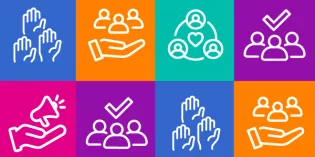Summary
Child health teams have already led the way in ‘hospital at home initiatives’ and we welcome NHS England’s focus on supporting systems to develop safe and effective paediatric virtual ward programmes.
However, it is important to recognise that virtual wards also require sufficient investment and workforce capacity to deliver high quality care for children, and they should be seen as a way to build system resilience to safely support the rising demand for acute paediatric care, and not as a way to reduce bed numbers or investment in children’s health services.;
While the principle may be sound, systems must consider the distinct needs of children and young people when planning and delivering paediatric virtual wards if they are to be effective. At a minimum, systems must ensure they have robust processes and workforce to recognise and manage deterioration, must invest in age-appropriate equipment and technology, and ensure inclusion/exclusion criteria take safeguarding considerations, the home environment and health inequalities into account.
Background
Expanding virtual wards is a priority area for NHS England, and the Urgent and Emergency Care delivery plan (PDF) identified virtual wards as one of the key interventions in to reduce pressure on hospital-based care. NHSE have committed to significantly expanding virtual ward capacity across the country, growing to 10,000 virtual ward beds by this Autumn, with the aim of caring for 50,000 patients a month in the next few years.
Around 170,000 patients have been treated on virtual wards so far, of which around 4% or 7,000 were children. While children currently make up a small proportion of virtual ward patients, this has been steadily increasing and around half of Integrated Care Boards now have virtual ward patients who are aged between 0-15 years. Delivering paediatric virtual wards is one of the two priorities for NHS England’s virtual ward programme this year, alongside virtual wards for heart failure, and NHSE are developing guidance and offering support to Integrated Care Boards to expand their paediatric virtual ward offer.
As a result of this increased focus, RCPCH is increasingly asked for the College’s position on paediatric virtual wards by government and NHSE officials and by College members. Virtual wards are one of the few areas of health service development where there is a specific focus on children, and it is crucial that the delivery of this model of care works well for children and the child health workforce. We have therefore outlined our position below.
What is a virtual ward?
Virtual wards, which include ‘hospital at home’ initiatives, are an alternative to hospital-based NHS care. Virtual wards combine face-to-face clinical provision with technology and remote monitoring, to enable high quality treatment, diagnosis and monitoring to be delivered in patients’ homes.
Paediatric virtual wards provide acute care to children and young people who would otherwise be in hospital. They should provide time-limited interventions, usually between two days and two weeks. Children can be directly admitted to virtual wards to prevent hospital admissions, or they can be admitted to virtual wards from hospitals to support early discharge.
Virtual wards usually have consultant oversight and nurse-delivered care but there is significant variation in set-up, with some delivered by community-based teams and others by hospital-based teams, and variation in whether they are staffed by separate virtual ward teams, or by the usual acute/community paediatric team.
Despite the ‘virtual’ name, virtual ward schemes include face-to-face visits from clinicians up to four times a day which could involve clinical staff administering medication, IV antibiotics and fluids, providing wound care, phototherapy, observations, and providing clinical reviews. There is usually also a technology component, with families using technology to monitor health data such as blood pressure, oxygen levels or heartrate, which is then sent to a dashboard to be reviewed by the clinical team as part of ‘virtual ward rounds’.
Which conditions could be managed on a virtual ward?
Children with many different conditions could be cared for in a virtual ward environment, when appropriate. This could include:
- Neonatal or paediatric jaundice
- Bronchiolitis
- Acute gastroenteritis
- Nephrotic syndrome
- Tonsilitis where fluid support is required
- Acute wheeze management
- Monitoring of febrile neutropenic patients
- More specialised pathways, such as the management of acute worsening of seizures for children with neurodisability
College position
Many paediatric teams have been delivering care outside of hospital settings through ‘hospital at home’ or ‘healthcare at home’ initiatives and through paediatric ambulatory services for many years, and in many respects child health teams have led the way in this model of home-based care.
Virtual wards can enable children with acute health needs to be cared for in a more familiar environment, and to avoid or shorten hospital stays which can be worrying, uncomfortable and even traumatic for some children. Virtual wards may be particularly valuable for children with long term conditions or high care demand such as rare neurodevelopmental disorders, who would otherwise be regularly in and out of hospital.
Being able to receive some of that care at home could have a significant impact on a child’s quality of life, helping with sleep, emotional wellbeing, and their ability to engage in usual activities and family and social interactions. It can also have benefits for parents and carers and any siblings, who are also impacted by frequent hospital stays. If delivered well, virtual wards could provide an opportunity for more holistic, family-centred care.
Emerging findings from systems who have implemented paediatric virtual wards suggest they are positively regarded by families and can shorten overall length of treatment and reduce the likelihood of ED attendance and readmission.
While these early findings seem positive, most research on virtual wards has focused on adults, and there are therefore some gaps in evidence around paediatric virtual wards and no clear consensus. There are additional considerations which must be thought through in order to ensure paediatric virtual wards provide safe and effective care for children. These are outlined below.
Where virtual wards provide additional capacity, they can be a useful model of care. However, we share the concerns raised by the Royal College of Physicians that it is important to ensure NHS targets to increase the number of virtual ward patients does not inadvertently lead to virtual wards being used for patients with low acuity who would not otherwise have been admitted to hospital or who would have been discharged. A target-driven approach and low risk appetite could result in a drift of purpose for virtual wards, with some patients being over monitored or medicalised.
Paediatric virtual wards should provide care for children who otherwise would have required hospitalisation. They should not be a mechanism for follow-up assessment, or for home IV or infusion services where continued admission would not otherwise be needed. If misused, this could reduce paediatric capacity in the long term. Clear pathways and inclusion/exclusion criteria are required to prevent this, as well robust escalation processes so virtual ward teams have confidence they can safely care for children with higher acuity.
The College is also clear that virtual wards should not be seen as a way to reduce overall bed numbers or workforce numbers. Virtual wards can help manage the rising demand for care by using resources differently, but they also require investment and adequate staffing. Virtual wards should be used to supplement hospital-based care, not to reduce the overall level of investment in child health services. An adequately resourced workforce is key to delivering safe and effective virtual wards and as much of the care will be nurse-led, we continue to challenge the Long Term Workforce Plan’s announcement of a 0% increase in child nursing numbers, compared to a 92% rise in adult nursing.
Considerations for systems to ensure effective paediatric virtual wards:
- Age-appropriate equipment – We welcome the use of technological innovations in healthcare. However, many of these tools are designed with adults in mind, and it is important investment in remote equipment and software considers the needs of children. Equipment must be suitable for children of all ages and sizes, for example correctly sized blood pressure cuffs. Software must include age-appropriate observation parameters and should be linked to national PEWS.
- Safeguarding considerations – Measures must be in place to appropriate identify and act upon any safeguarding concerns. All virtual wards should have clear inclusion and exclusion criteria which should be determined with safeguarding in mind. These criteria must also fit with existing clinical guidelines, for example ensuring non-mobile children with bruising are always admitted to a hospital ward.
- Managing deterioration and risk – Children can deteriorate quickly, and this must be considered in the design of paediatric virtual wards. National virtual ward guidance requires staffing for at least 12 hours a day, 7 days a week. However, it is important to recognise that for some conditions such as respiratory illnesses, children often deteriorate overnight and there must be clear pathways in place for this. Families should be given clear, accessible information about who to contact and what to do if symptoms worsen, including if they worsen out of hours. Inclusion and exclusion criteria must also take this into account, for example in particularly remote areas. All staff working with paediatric virtual wards should have adequate training to ensure deterioration is detected and responded to appropriately. To avoid the pitfall of virtual wards being used for well patients, there needs to be a well thought out approach to risk and clear pathways to manage deterioration safely.
- Alignment with other paediatric initiatives – Systems need to consider how virtual wards fit with other paediatric service developments, such as rapid access clinics, SDEC, and acute respiratory infection hubs. Clear pathways are needed to prevent confusion or duplication, and these should be communicated to the child health workforce and to families, children and young people. Where there are existing paediatric hospital at home initiatives, it should be made clear how these align with the virtual ward programme.
- Good communication and information sharing – Clear communication and joint working between community and acute teams, and between dedicated virtual ward teams and wider paediatric teams is essential. Where virtual wards are managed by community-based teams, clear routes for communication with the acute paediatric on-call team is needed.
- Health inequalities – Research by the Health Foundation on public attitudes to virtual wards found that while more of the public were supportive of virtual wards (45% supportive, 36% unsupportive, 19% don’t know), support varied by socioeconomic group. People from socioeconomic group DE were on balance unsupportive, compared to those in groups C1, C2 and AB who were supportive. This means patients who are more likely to experience sharp health inequalities are also less likely to want to be cared for in virtual wards. The top three reasons people gave for not wanting virtual wards were consistent across all socioeconomic groups (preference for face-to-face care; concerns about quality of care; concerns they would not be able to access a health professional quickly.) However, considerably more respondents in socioeconomic group DE were also concerned their home was not a suitable environment. This was not due to concerns about access to technology which very few people in any socioeconomic group mentioned. More research is needed to unpick these findings and what lies behind them. It is important that paediatric virtual ward programmes take the home environment into account and are designed to mitigate against rather than exacerbate existing health inequalities.
- Coproduction with children, young people and families – Coproduction with children and families should be at the heart of service design, including of virtual ward initiatives. There is minimal research on children and young people’s attitudes towards virtual wards, compared to the views of adult patients. Recent research by the Health Foundation only covered those aged 16+ but found that the youngest age group surveyed (16-24) were the least supportive of virtual wards. Engagement with children and young people is needed to ensure that virtual wards work well for them.










